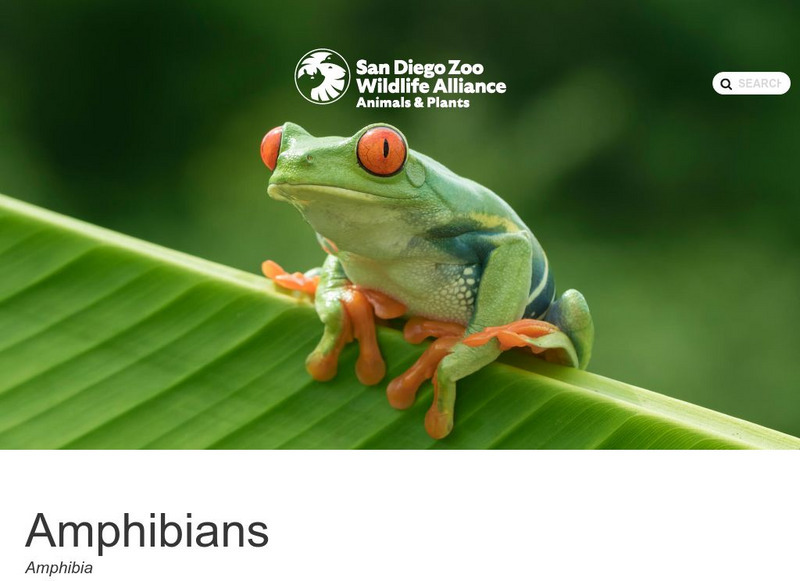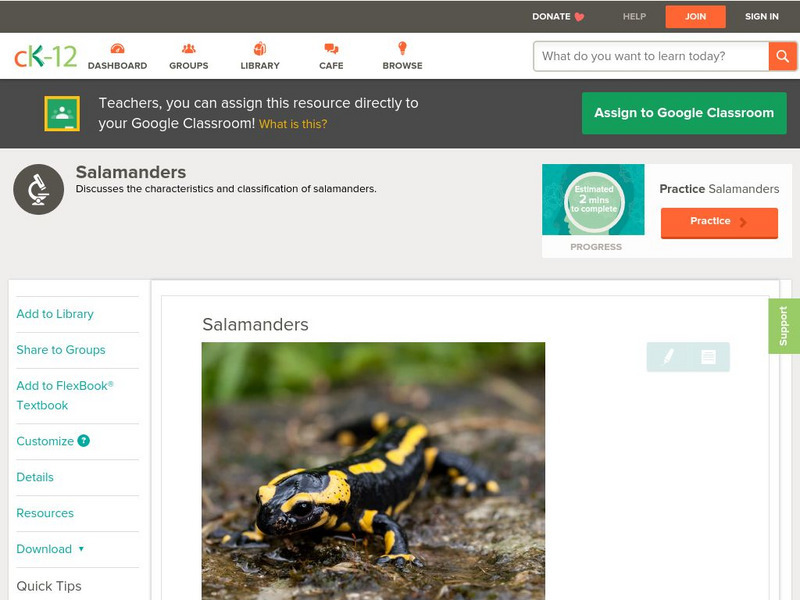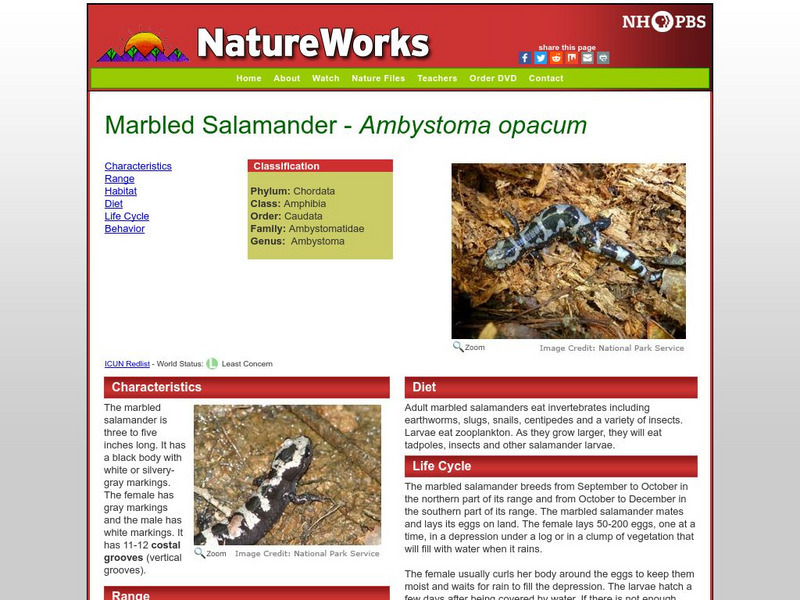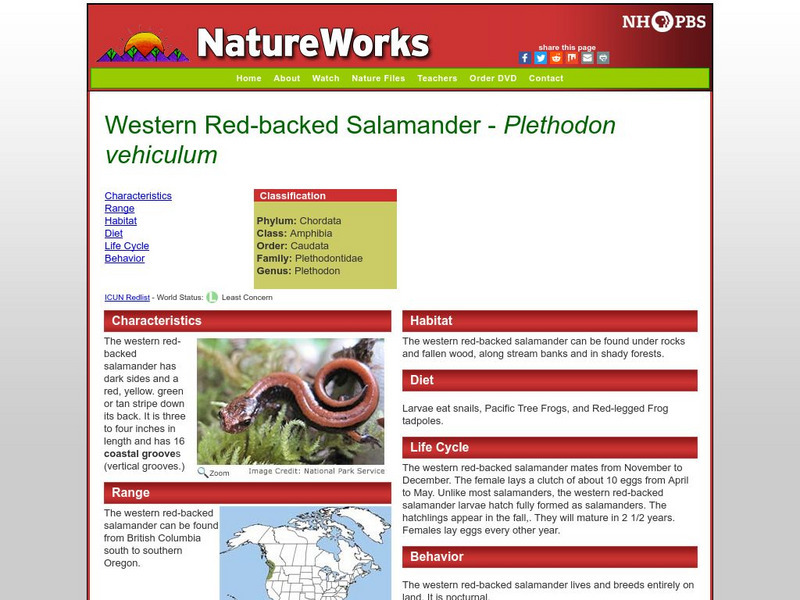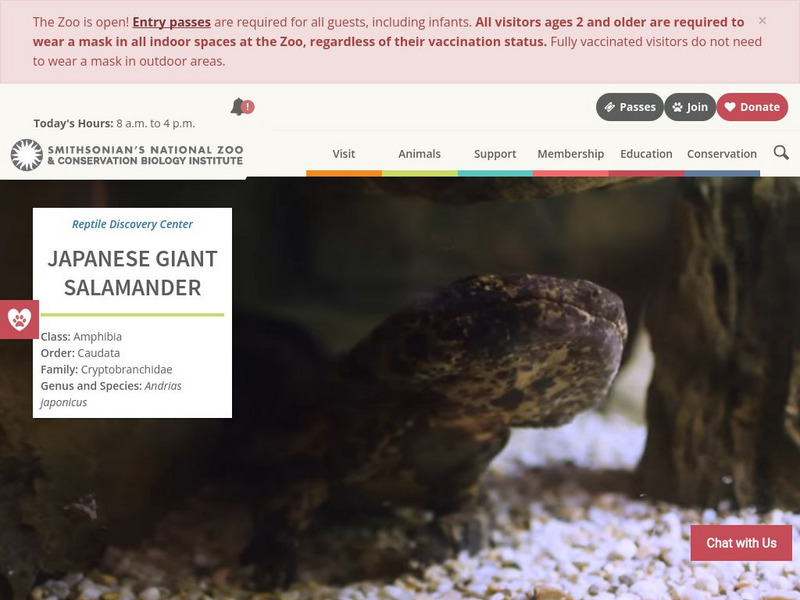Curated OER
Animal Classifications
While short, this resource could be used as an overview of amphibians. The presentation lists the characteristics of amphibians and provides several examples. For use in a classroom, a teacher could add information.
Curated OER
Amphibians
In this amphibian worksheet, students will review the characteristics of the class Amphibia, including frogs and toads, salamanders, and caecilians. This worksheet has 3 short answer questions, 5 matching questions, 6 multiple choice,...
Curated OER
Talking 'Bout Regeneration
Students research the regenerative capabilities of certain organisms. They present their findings at a student regeneration symposium aimed at exploring the possibilities of human regeneration.
Curated OER
In the Field with Salamanders
Students observe salamanders, take pictures of them, and classify them into an online format. In this animal classification lesson, students use collection materials and digital camera to photograph and observe salamanders. Students...
University of Michigan
University of Michigan Critter Catalog: Amphibians
This site provides a general description of amphibians and then describes in detail the characteristics of local animals in southern Michigan. Pictures, classification information, and sound clips of some amphibians are provided.
Utah Education Network
Uen: Trb 4:5 Investigation 12 Amphibians & Reptiles
Activity provides for comparing and contrasting the behavior and structure of amphibians and reptiles of Utah.
Environmental Education for Kids
Eek!: Amphibians
Amphibians are cold-blooded, smooth-skinned vertebrates. Most live some of their life in water and some on land. The most common amphibian critter is a frog but there are many others. Read about Wisconsin's many amphibians here.
Sheppard Software
Sheppard Software: Salamanders
This site gives an in-depth description of a salamander, including its behavior, appearance, reproduction, and classification. The site includes photos and illustrations and an interactive quiz to test your understanding.
PBS
Nh Pbs: Nature Works: California Tiger Salamander
This site created by NatureWorks focuses on the California Tiger Salamander. The content of this resource includes a look at this species' characteristics, range, habitat, food, reproduction, and behavior.
Regents of the University of Michigan
Animal Diversity Web: Salamandra Salamandra (Fire Salamander)
Site contains information on the Salamandra Salamandra (Fire Salamander). Includes geographic range, habitat, physical description, reproduction, behavior, food habits, and conservation status as well as other information and pictures.
Other
Caudata Culture: Crested Newts
This site describes the four species of crested newts, including information regarding their range and hatitat, and the similarities and differences of the species.
A-Z Animals
A Z Animals: Animal Facts: Tiger Salamander (Ambystoma Tigrinum)
This entry identifies the defining characteristics of the Ambystoma Tigrinum, more commonly known as the Tiger Salamander.
San Diego Zoo Global
San Diego Zoo: Amphibians
This resource offers extensive information about amphibians. Visitors can click on the listed amphibians for further information.
CK-12 Foundation
Ck 12: Life Science: Salamanders
[Free Registration/Login may be required to access all resource tools.] Salamanders are characterized by slender bodies, short legs, and long tails. They are most closely related to the caecilians, little-known legless amphibians. Learn...
PBS
Nh Pbs: Nature Works: Blue Spotted Salamander
This site created by NatureWorks focuses on the Blue-Spotted Salamander. The content of this resource includes a look at this species' characteristics, range, habitat, food, and more.
PBS
Nh Pbs: Nature Works: Marbled Salamander
The marbled salamander lives in forests and woodlands in the eastern part of the United States, where it is an endangered species in certain states. Students and teachers will find the content to include a look at the species' life...
Encyclopedia of Life
Encyclopedia of Life: Amphibians
Thorough resource investigates amphibians with a description, pictures, and maps. Includes facts on ecology, evolution, biology, and external links.
University of Michigan
University of Michigan Critter Catalog: Frogs & Toads
This competent site provides general information about amphibians and then focuses on the amphibians found in southeastern Michigan. Information, pictures, sound clips, and classification groupings are provided.
PBS
Nh Pbs: Nature Works: Western Red Backed Salamander
Learn more about the Western Red-Backed Salamander through the exploration of this resource. This site features information ranging from characteristics and range to life cycle and diet.
American Museum of Natural History
American Museum of Natural History: Hellbender O Logy Card
OLogy cards are like virtual baseball cards about all kinds of science topics. This one is about a salamander called the hellbender and it contains information about the habitat, diet, and other ecological information. See if you can...
Environmental Education for Kids
Eek!: Species With Status: Common
Common species are those that exist in large numbers. A species may be locally abundant, but not broadly common. Examples of common Wisconsin species are presented here.
Canadian Museum of Nature
Canadian Museum of Nature: Amphibians
Provides fascinating facts and images of frogs and salamanders plus a map of where they can be found.
Smithsonian Institution
Smithsonian National Zoo: Japanese Giant Salamander
As part of the Asia Trail exhibit at the National Zoo, this site highlights various facts and interesting information on the Japanese Giant Salamander. In addition to several pictures, the site provides a description and information on...
Ducksters
Ducksters: Amphibians for Kids: Frogs, Salamanders, and Toads
What is an amphibian? Kids learn about these cold blooded animals including salamanders, frogs, and toads. Lifecycle such as tadpole and metamorphosis.













